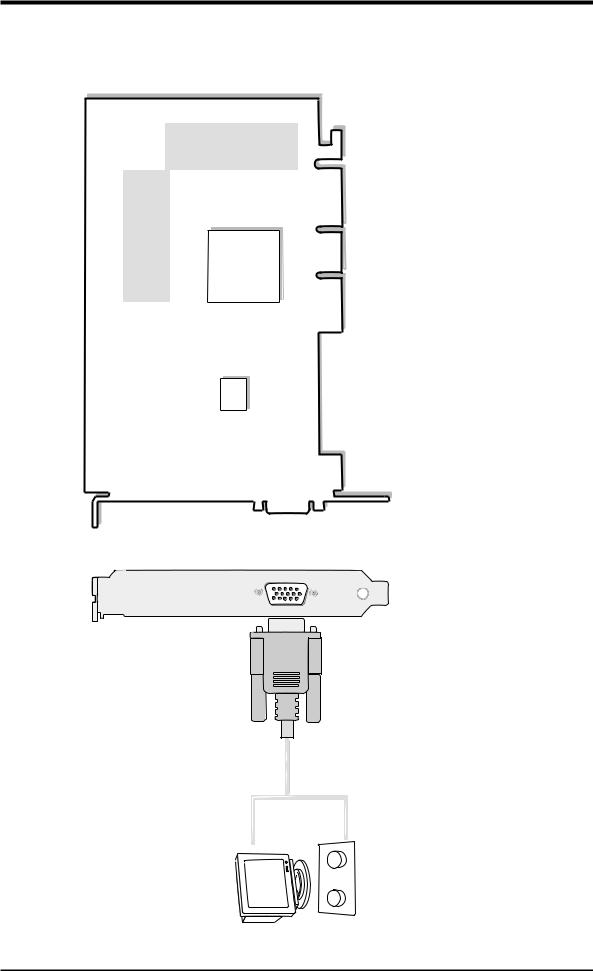Asus V300C Manual

R
AGP-V300C Series
High Speed 3D/2D Graphics Card
with DVD Acceleration
USER’S MANUAL
Hardware & Video Drivers
AGP-V300C / 16MB

USER’S NOTICE
No part of this manual, including the products and software described in it, may be reproduced, transmitted, transcribed, stored in a retrieval system, or translated into any language in any form or by any means, except documentation kept by the purchaser for backup purposes, without the express written permission of ASUSTeK COMPUTER INC. (“ASUS”).
ASUS PROVIDES THIS MANUAL “AS IS” WITHOUT WARRANTY OF ANY KIND, EITHER EXPRESS OR IMPLIED, INCLUDING BUT NOT LIMITED TO THE IMPLIED WARRANTIES OR CONDITIONS OF MERCHANTABILITY OR FITNESS FOR A PARTICULAR PURPOSE. IN NO EVENT SHALL ASUS, ITS DIRECTORS, OFFICERS, EMPLOYEES OR AGENTS BE LIABLE FOR ANY INDIRECT, SPECIAL, INCIDENTAL, OR CONSEQUENTIAL DAMAGES (INCLUDING DAMAGES FOR LOSS OF PROFITS, LOSS OF BUSINESS, LOSS OF USE OR DATA, INTERRUPTION OF BUSINESS AND THE LIKE), EVEN IF ASUS HAS BEEN ADVISED OF THE POSSIBILITY OF SUCH DAMAGES ARISING FROM ANY DEFECT OR ERROR IN THIS MANUAL OR PRODUCT.
Product warranty or service will not be extended if: (1) the product is repaired, modified or altered, unless such repair, modification of alteration is authorized in writing by ASUS; or
(2) the serial number of the product is defaced or missing.
Products and corporate names appearing in this manual may or may not be registered trademarks or copyrights of their respective companies, and are used only for identification or explanation and to the owners’ benefit, without intent to infringe.
•SiS and SiS305 are trademarks of Silicon Integrated Systems Corp. (SiS).
•Windows, MS-DOS, and DirectX are registered trademarks of Microsoft Corporation.
•Adobe and Acrobat are registered trademarks of Adobe Systems Incorporated.
The product name and revision number are both printed on the product itself. Manual revisions are released for each product design represented by the digit before and after the period of the manual revision number. Manual updates are represented by the third digit in the manual revision number.
For previous or updated manuals, BIOS, drivers, or product release information, contact ASUS at http://www.asus.com.tw or through any of the means indicated on the following page.
SPECIFICATIONS AND INFORMATION CONTAINED IN THIS MANUAL ARE FURNISHED FOR INFORMATIONAL USE ONLY, AND ARE SUBJECT TO CHANGE AT ANY TIME WITHOUT NOTICE, AND SHOULD NOT BE CONSTRUED AS A COMMITMENT BY ASUS. ASUS ASSUMES NO RESPONSIBILITY OR LIABILITY FOR ANY ERRORS OR INACCURACIES THAT MAYAPPEAR IN THIS MANUAL, INCLUDING THE PRODUCTS AND SOFTWARE DESCRIBED IN IT.
Copyright © 2000 ASUSTeK COMPUTER INC. All Rights Reserved.
Product Name: |
ASUS V300C Series |
Manual Revision: |
1.00 E573 |
Release Date: |
June 2000 |
|
|
2 |
ASUS AGP-V300C Series User’s Manual |

ASUS CONTACT INFORMATION
ASUSTeK COMPUTER INC. (Asia-Pacific)
Marketing
Address: |
150 Li-Te Road, Peitou, Taipei, Taiwan 112 |
Telephone: |
+886-2-2894-3447 |
Fax: |
+886-2-2894-3449 |
Email: |
info@asus.com.tw |
Technical Support
MB/Others (Tel): |
+886-2-2890-7121 (English) |
|
Notebook (Tel): |
+886-2-2890-7122 |
(English) |
Desktop/Server (Tel):+886-2-2890-7123 |
(English) |
|
Fax: |
+886-2-2895-9254 |
|
Email: |
tsd@asus.com.tw |
|
WWW: |
www.asus.com.tw |
|
FTP: |
ftp.asus.com.tw/pub/ASUS |
|
ASUS COMPUTER INTERNATIONAL (America)
Marketing
Address: |
6737 Mowry Avenue, Mowry Business Center, Building 2 |
|
Newark, CA 94560, USA |
Fax: |
+1-510-608-4555 |
Email: |
tmd1@asus.com |
Technical Support
Fax: |
+1-510-608-4555 |
Email: |
tsd@asus.com |
WWW: |
www.asus.com |
FTP: |
ftp.asus.com/Pub/ASUS |
ASUS COMPUTER GmbH (Europe)
Marketing
Address: |
Harkortstr. 25, 40880 Ratingen, BRD, Germany |
Fax: |
+49-2102-442066 |
Email: |
sales@asuscom.de (for marketing requests only) |
Technical Support
Hotline: |
MB/Others: +49-2102-9599-0 Notebook: +49-2102-9599-10 |
Fax: |
+49-2102-9599-11 |
Support (Email): |
www.asuscom.de/de/support (for online support) |
WWW: |
www.asuscom.de |
FTP: |
ftp.asuscom.de/pub/ASUSCOM |
ASUS AGP-V300C Series User’s Manual |
3 |

CONTENTS
I. Introduction ..................................................................................... |
7 |
Highlights ......................................................................................... |
7 |
Available Model ............................................................................... |
7 |
ASUS V300C ............................................................................. |
7 |
Features ............................................................................................ |
8 |
II. Hardware Setup .............................................................................. |
9 |
ASUS AGP-V300C Layout ............................................................. |
9 |
Installation Procedures ................................................................... |
10 |
New Systems ............................................................................ |
10 |
Systems with Existing VGA Card ............................................ |
10 |
III. Software Setup ............................................................................ |
11 |
Operating System Requirements ................................................... |
11 |
Windows 98 .............................................................................. |
11 |
Display Driver Installation ............................................................. |
12 |
Windows 98 .............................................................................. |
12 |
Method 1: ASUS Quick Setup Program ............................. |
12 |
Method 2: Display Property Page ....................................... |
13 |
Method 3: Plug and Play .................................................... |
14 |
Windows 2000 .......................................................................... |
14 |
Method 1: ASUS Quick Setup Program ............................. |
14 |
Method 2: Plug and Play .................................................... |
15 |
Windows NT 4.0 ...................................................................... |
17 |
Method 1: Display Property Page ....................................... |
17 |
4 |
ASUS AGP-V300C Series User’s Manual |

CONTENTS |
|
Setup Components ......................................................................... |
18 |
Windows 98 .............................................................................. |
18 |
Windows 2000 .......................................................................... |
18 |
Windows NT 4.0 ...................................................................... |
18 |
Uninstall Display Driver .......................................................... |
19 |
Windows 98 ........................................................................ |
19 |
Method1: Using the Uninstall Utility ........................... |
19 |
Method 2: Using Control Panel .................................... |
19 |
Windows 2000 .................................................................... |
20 |
Method1: Using the Autorun Screen ............................ |
20 |
Method 2: Using Control Panel .................................... |
20 |
Windows NT 4.0 ................................................................. |
20 |
Method 1: Using Control Panel .................................... |
20 |
IV. Software Reference ..................................................................... |
21 |
ASUS Control Panel ...................................................................... |
21 |
Windows 9x .............................................................................. |
21 |
Windows 2000/Windows NT 4.0 ............................................. |
29 |
V. Resolution Table ........................................................................... |
33 |
2D Video Modes ............................................................................ |
33 |
Maximum 3D Video Modes ........................................................... |
33 |
VI. Troubleshooting .......................................................................... |
35 |
Description ..................................................................................... |
35 |
Recommended Action .................................................................... |
35 |
ASUS AGP-V300C Series User’s Manual |
5 |

FCC & DOC COMPLIANCE
Federal Communications Commission Statement
This device complies with FCC Rules Part 15. Operation is subject to the following two conditions:
•This device may not cause harmful interference, and
•This device must accept any interference received, including interference that may cause undesired operation.
This equipment has been tested and found to comply with the limits for a Class B digital device, pursuant to Part 15 of the FCC Rules. These limits are designed to provide reasonable protection against harmful interference in a residential installation. This equipment generates, uses and can radiate radio frequency energy and, if not installed and used in accordance with manufacturer’s instructions, may cause harmful interference to radio communications. However, there is no guarantee that interference will not occur in a particular installation. If this equipment does cause harmful interference to radio or television reception, which can be determined by turning the equipment off and on, the user is encouraged to try to correct the interference by one or more of the following measures:
•Reorient or relocate the receiving antenna.
•Increase the separation between the equipment and receiver.
•Connect the equipment to an outlet on a circuit different from that to which the receiver is connected.
•Consult the dealer or an experienced radio/TV technician for help.
WARNING! The use of shielded cables for connection of the monitor to the graphics card is required to assure compliance with FCC regulations. Changes or modifications to this unit not expressly approved by the party responsible for compliance could void the user’s authority to operate this equipment.
Canadian Department of Communications Statement
This digital apparatus does not exceed the Class B limits for radio noise emissions from digital apparatus set out in the Radio Interference Regulations of the Canadian Department of Communications.
This Class B digital apparatus complies with Canadian ICES-003.
Cet appareil numérique de la classe B est conforme à la norme NMB-003 du Canada.
Macrovision Corporation Product Notice
This product incorporates copyright protection technology that is protected by method claims of certain U.S. patents and other intellectual property rights owned by Macrovision Corporation and other rights owners. Use of this copyright protection technology must be authorized by Macrovision Corporation, and is intended for home and other limited viewing uses only unless otherwise authorized by Macrovision Corporation. Reverse engineering or disassemby is prohibited.
6 |
ASUS AGP-V300C Series User’s Manual |

I. Introduction
Thank you for purchasing an ASUS V300C High Speed 3D/2D Graphics Card with DVD Acceleration.
Powered by Silicon Integrated Systems Corp. (SiS) SiS305 128-bit real 3D/2D/Video/ DVD accelerator chip, the ASUS V300C is designed for value-conscious graphics enthusiasts.
Using the SiS chip, the ASUS V300C delivers high-powered 3D and 2D graphics performance, making it ideal for high-powered desktop PC users.
With the ASUS V300C, you will not only see but also experience dynamic, realistic 3D worlds and characters.
Highlights
•New SiS305 128-bit 3D graphics accelerator
•270 MHz RAMDAC
•High performance DVD playback
•Full support for DirectX7 & OpenGL
•Optional upgrade kit — ASUS DVD player
Available Model
ASUS V300C
•16MB Frame Buffer
•VGA
I. Introduction
Features
ASUS AGP-V300C Series User’s Manual |
7 |

Features
.I
Introduction
I. Introduction
Features
•2D/GUI/DirectDraw Acceleration
•Full featured 64-bit BitBLT Engine and 128-bit 3D engine
•Turbo Queue Architecture with 2D engine to solve 3D and 2D command order problem
•Multi buffering (Double, Triple, Quad buffering) for smooth animation
•Burst frame buffer read/write
•Up to 133 MHz 3D engine clock and 125 MHz memory clock
•Peak polygon rate: 4M polygon/sec @ 1 pixel/polygon with 16 bpp, bilinear textured, Z buffered, and alpha blended
•Individual Z-buffer and render buffer at the same time
•High precision 32/24/16 bpp Z buffer integer/floating formats
•Per-Pixel perspective texture mapping (Fog, Lighting, Mipmapping)
•MipMAP with point-sampled, linear, bi-linear, and tri-linear texture filtering
•Single pass two MipMAP texture
•Anti-aliasing: sort dependent edge, full scene
•Windows 95/98, Windows NT4.0 with Service Pack 3.0 Display Driver, including full DirectX7, and OpenGL ICD
8 |
ASUS AGP-V300C Series User’s Manual |

II. Hardware Setup
ASUS AGP-V300C Layout
16MB Frame Buffer
16MB Frame Buffer
SiS 5 Chip
03
BIOS
VGA
VGA Monitor output (15pin) (standard)
VGA Output


 Projector
Projector
H/WSetup |
Layout |
II. |
|
|
|
ItemChecklist |
ASUSAGP-V300CGraphicsCard ThisUser’sManual ASUSAGP-V300CSeriesDriver&UtilityCDDisc |
ASUS AGP-V300C Series User’s Manual |
9 |

Procedures
.II
Setup H/W
II. Hardware Setup
NOTE: This graphics card series can only be installed in motherboards with an AGP slot.
WARNING! Computer boards and components contain very delicate Integrated Circuit (IC) chips. To protect the computer board and other components against damage from static electricity, you must follow some precautions.
1.Make sure that you unplug your power supply when adding or removing expansion cards or other system components. Failure to do so may cause severe damage to both your motherboard and expansion cards.
2.Keep all components such as the host adapter in its antistatic bag until you are ready to install it.
3.Use a grounded wrist strap before handling computer components. If you do not have one, touch both of your hands to a safely grounded object or to a metal object, such as the power supply case. Hold components by the edges and try not to touch the IC chips, leads, or circuitry.
4.Place components on a grounded antistatic pad or on the bag that came with the component whenever the components are separated from the system.
Installation Procedures
New Systems
1.Unplug all electrical cords on your computer.
2.Remove the system unit cover.
3.Locate the AGP bus expansion slot. Make sure this slot is unobstructed.
4.Remove the corresponding expansion slot cover from the computer chassis.
5.Ground yourself to an antistatic mat or other grounded source .
6.Pick up the board (still in its sleeve) by grasping the edge bracket with one hand and then remove the plastic sleeve.
7.Position the card directly over the AGP slot and insert one end of the board in the slot first. Firmly but gently press the bus connector on the bottom of the card down into the slot. Be sure the metal contacts on the bottom of the host adapter are securely seated in the slot.
8.Anchor the board’s mounting bracket to the computer chassis using the screw from the slot cover that you set aside previously.
9.Replace the cover on the system unit.
10.Connect your analog monitor’s 15-pin VGA connector to the card and fasten the retaining screws (if any).
11.Connect other cables and devices if available -You are now ready to install the software drivers and utilities.
Systems with Existing VGA Card
1.Change your display driver to Standard VGA.
2.Shut down your computer and unplug all electrical cords.
3.Replace the existing VGA card with your graphics card.
4.Restart your computer.
5.Install the ASUS V300C series display driver.
10 |
ASUS AGP-V300C Series User’s Manual |

III. Software Setup
Operating System Requirements
NOTE: This graphics card requires a motherboard with an AGP slot.
Windows 98
Windows 98 supports full Direct3D and AGP features. If you are still using the beta version of Windows 98 and you want to fully take advantage the Direct3D and AGP features, you must upgrade your current Windows to the release version before installing the AGP display driver.
Windows 98 includes VGARTD for the major chipsets but it is recommended that you install VGARTD from the ASUS V300C Series CD to make sure that you have the latest version of VGARTD (see III. Software Setup | Display Driver Installation | Windows 98).
NOTES
•VGARTD stands for Virtual Graphics Address Remapping Table Driver, which is necessary to use the DIME feature of AGP. DIME means Direct Memory Execute, which is accessed directly by most AGP chips (when VGARTD is installed) for complex texture-mapping operations
•This Manual assumes that your CD-ROM disc drive is drive D: and that Windows is in C:\WINDOWS. Replace either with the actual location, if necessary.
III. S/W Setup
OS Requirements
ASUS AGP-V300C Series User’s Manual |
11 |

Drivers Display
Setup S/W .III
III. Software Setup
Display Driver Installation
You can use one of the recommended methods to install the display drivers for your ASUS V300C series graphics card, depending on your operating system.
NOTE: The screen displays in this manual may not reflect exactly the screen contents displayed on your screen. The contents of the support CD are subject to change at any time without notice. The procedures assume that your CD-ROM drive is drive D:.
Windows 98
IMPORTANT! The appropriate AGP GART driver must be installed first if your motherboard does not use the Intel AGPset. Installing the AGP GART driver will ensure that the AGPset’s AGP functions are available. To install,
1.Insert the CD installation disc into your CD-ROM drive.
2.Click Start button, and then click Run.
3.In Open, type D:\VGARTD\VGINST.EXE and then click OK. Follow the onscreen instructions to finish setup.
Method 1: ASUS Quick Setup Program
1.Start Windows.
2.Switch display to Windows’ Standard Display Adapter (VGA) mode and then restart Windows.
3.Insert the CD installation disc into your CD-ROM drive.
4.Click Start button, and then click Run.
5.In Open, type D:\WIN9X\SETUP.EXE and then click OK. The ASUS Multimedia Package Setup program opens.
6.Follow the onscreen instructions to complete the setup.
7.When Setup has finished installing all the necessary files on your computer, it will prompt you to restart your computer. Click Yes... and then Finish to restart your computer and to complete Setup.
12 |
ASUS AGP-V300C Series User’s Manual |
